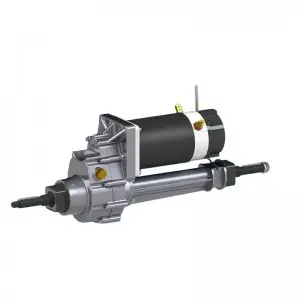When it comes to understanding the mechanics of a vehicle, the transaxle plays a vital role in determining whether the car is front-wheel drive (FWD) or rear-wheel drive (RWD). The transaxle is a critical component of the powertrain, and its design and arrangement have a significant impact on the vehicle’s performance and handling. In this article, we’ll delve into the concept of a transaxle, explore the differences between front-wheel drive and rear-wheel drive transaxles, and discuss the pros and cons of each.
First, let’s define what a transaxle is and its main function. The transaxle is a single integrated unit that combines the transmission, differential and axle shafts in a single housing. This design is common in front-engine, front-wheel drive vehicles, where the transaxle is located at the front of the car and is connected directly to the engine. In rear-wheel drive vehicles, the transmission and differential are separate components, with the transmission usually located at the front of the vehicle and the differential at the rear.
Now, let’s get this out of the way: Is the transaxle front-wheel drive or rear-wheel drive? The answer lies in the configuration and placement of the transaxle within the vehicle. In a front-wheel drive vehicle, the transaxle is located at the front and is responsible for transferring power from the engine to the front wheels. This layout allows for better weight distribution, improved traction and more efficient use of interior space. On the other hand, in a rear-wheel drive vehicle, the transaxle is located at the rear and power is transmitted to the rear wheels, thus providing different advantages and features.
One of the main differences between front-wheel drive and rear-wheel drive transaxles is the way they handle power delivery and vehicle dynamics. In front-wheel drive vehicles, the transaxle is located at the front, allowing for a more compact and efficient drivetrain layout. This configuration also helps provide better traction, especially in adverse weather conditions, because the weight of the engine is directly on the driven wheels. Additionally, front-wheel drive vehicles tend to have better fuel efficiency due to simpler drivetrain designs and fewer mechanical losses.
In contrast, rear-wheel drive transaxles offer clear advantages in handling and performance. By placing the transaxle at the rear, rear-wheel drive vehicles achieve a more balanced weight distribution, which improves handling and stability, especially at high speeds and when cornering. The rear-wheel-drive layout also allows for better power transmission because the front wheels no longer have the task of steering and propulsion, resulting in a more dynamic driving experience.
Both front- and rear-wheel drive axles have their own set of considerations when it comes to maintenance and repairs. FWD transaxles are generally easier to service due to their accessibility and compact design. However, they may be more susceptible to certain types of wear, such as constant velocity (CV) joint problems. On the other hand, rear-wheel drive transaxles, while more complex, offer better durability and longevity, especially in high-performance applications.
Notably, advances in automotive engineering have led to the development of all-wheel drive (AWD) and four-wheel drive (4WD) systems that employ transaxles in different configurations to accommodate different driving conditions. All-wheel drive systems typically use a transaxle at the front, with an additional driveshaft and differential to power the rear wheels when needed. On the other hand, four-wheel drive systems typically have separate transfer cases that distribute power to the front and rear axles, while the transaxle remains at the front of the vehicle.
In summary, the transaxle plays a key role in determining whether a vehicle is front-wheel drive or rear-wheel drive, and each configuration has its own advantages and characteristics. Whether it’s the efficient packaging and traction of a front-wheel drive axle, or the dynamic handling and performance of a rear-wheel drive axle, understanding the differences between these drivetrain layouts is crucial for car enthusiasts and daily drivers alike. As technology continues to evolve, the role of the transaxle in modern vehicles will undoubtedly continue to shape the driving experience for years to come.
Post time: Jul-29-2024


